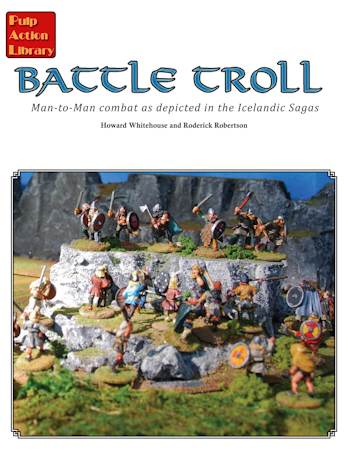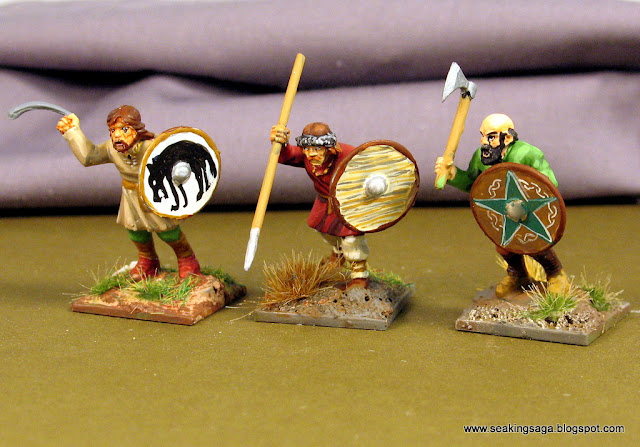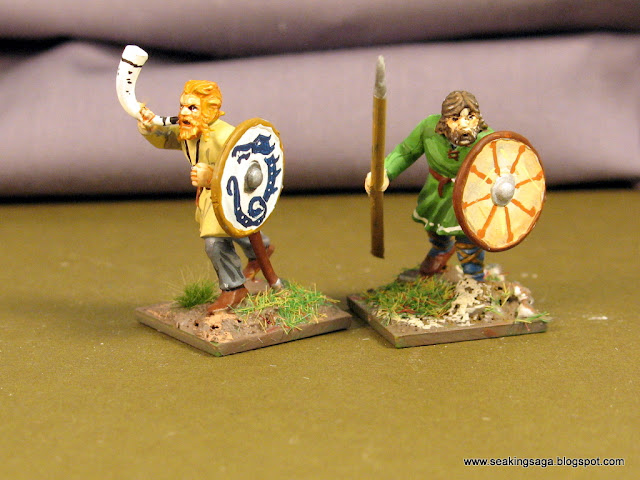Battle Troll, by Pulp Action Library, is a Viking skirmish game that is most directly inspired by the Icelandic Sagas. The authors, Howard Whitehouse and Roderick Robertson, set about to recreate the rivalries and blood feuds of early Icelandic history. It was a tough and lawless environment, and with people living so close to the edge of survival, deadly feuds erupted over the inheritance of lands, lost livestock and arrangement of marriages. While written with a great deal of humor, there is also a lot of research and respect for the sagas to be found. After all, it includes as characters both the real life Leif Ericsson and an original named Gudrun the Slutty. What's not to like?
To get started, one needs a rulebook, available from
Wargames Vault or
RPG Now as a printable pdf ($18) or a softcover edition ($24, including PDF), along with a set of cards as an extra purchase ($4 PDF/$8 printed).
The book is well organized and clearly written. Totaling 78 pages, the rules are contained in the first 24. The remainder of the book is scenarios and campaign instructions, and it should not take more than two read-throughs to begin play. Production quality could be better. There are lots of color photos of Viking minis, but the painting standard and photo quality do not holdup in comparison to the popular historical wargame rules on the market right now.
The gameplay is card driven with outcomes determined by dice rolls. The two card decks are an Action deck, which determines initiative, and a Combat deck, which determines melee maneuvers. Each player (up to 4) has a number of cards that can activate heroes, the warband or non-combatants. Another card is the End Turn card. A random draw determines initiative, and I am always glad to see a variation on the IGYG system.

I found the Combat card melee to be the most interesting part of the game. It is basically a rock-paper-scissors mechanic, with the attacker's and defender's cards determining the number of dice they roll against each other. For example, if the attacker draws lunge, and the defender draws parry, the attacker gets one roll and the defender two. A swing gets the attacker three dice, and the defender just one. Other options include a jest, which does no damage, but can earn reputation points, and accidents. If fighting with a hero character, the player can choose which attack or defense to use, but the cards are randomly drawn for lower level warriors.
 |
| Nice line artwork on the back of the combat cards |
Combat can be extremely detailed, with save rolls, hit location charts and differing armor effects. Thankfully, these rules can be quickly streamlined to speed up gameplay. I played a seven on seven match in just under 30 minutes. Heroes are hard to kill in this game, especially if fighting inferior opponents. Again, in the Icelandic Sagas, Gunnar supposedly killed more than a dozen enemies who ambushed him. That's not likely to happen in a more realistic game system, but in the dramatized and larger than life world of Battle Troll, it is just possible.
Another element that the game adds is Reputation Points, to mimic the importance of great feats in the Norse sagas. Similar to victory points, Reputation can be won or lost in battle, or by delivering taunts at the enemy, and even dying a glorious death.
To test the game, I put together a short scenario scenario involving 21 crew members of a Viing ship arguing over the division of a meager raid. Seven warriors on each side: 1 hero, 3 hirdmen, and 3 bondi. Also, seven men are undecided and sitting the fight out. They enter the fight under certain circumstances: if one side gets an advantage of more than 10 Reputation points, an undecided warrior joins that side.
The jarl and his men are in the lower left corner, the mutinous dogs/mistreated warriors are approaching from the right. Those hedging their bets are waiting behind the tent to see who to support.
 |
| After doing very well at first, the jarl's men collapse upon his death and flee from the camp. |
Final Analysis: With the campaign rules, and detailed individual combat, Battle Troll occupies territory between an RPG and a wargame, which is neither and advantage nor disadvantage from my point of view. It encourages banter and storytelling between players which is in keeping with the flavor of the period. At the same time, Battle Troll has good potential for solo gamers with the random card element. Finally, it is a bit pricey for what I expect to pay for a PDF, but if one were to compare the printed edition on a price per page basis to other rule systems, it still comes up cheaper. Ultimately, you're paying for the rules and writing, not slick paper and pro photography.


























